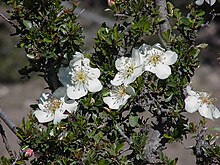| Maleae Temporal range: | |
|---|---|
 | |
| Lindleya mespiloides in bloom | |
| Scientific classification | |
| Kingdom: | Plantae |
| Clade: | Tracheophytes |
| Clade: | Angiosperms |
| Clade: | Eudicots |
| Clade: | Rosids |
| Order: | Rosales |
| Family: | Rosaceae |
| Subfamily: | Amygdaloideae |
| Tribe: | Maleae Small 1933 |
| Subtribes | |
| Synonyms | |
The Maleae (incorrectly Pyreae) are the apple tribe in the rose family, Rosaceae. The group includes a number of plants bearing commercially important fruits, such as apples and pears, while others are cultivated as ornamentals. Older taxonomies separated some of this group as tribe Crataegeae, [2] [3] as the Cydonia group (a tentative placement), [3] or some genera were placed in family Quillajaceae. [3]
Contents
- Current classification
- Core members of the group
- Tribe Crataegeae
- Former members of family Quillajaceae
- The Cydonia group
- References
The tribe consists exclusively of shrubs and small trees. Most have pomes, a type of accessory fruit that does not occur in other Rosaceae. All except Vauquelinia (with 15 chromosomes) have a basal haploid chromosome count of 17, instead of 7, 8, or 9 as in the other Rosaceae. [4]
There are approximately 28 genera that contain about 1100 species worldwide, with most species occurring in the temperate Northern Hemisphere.